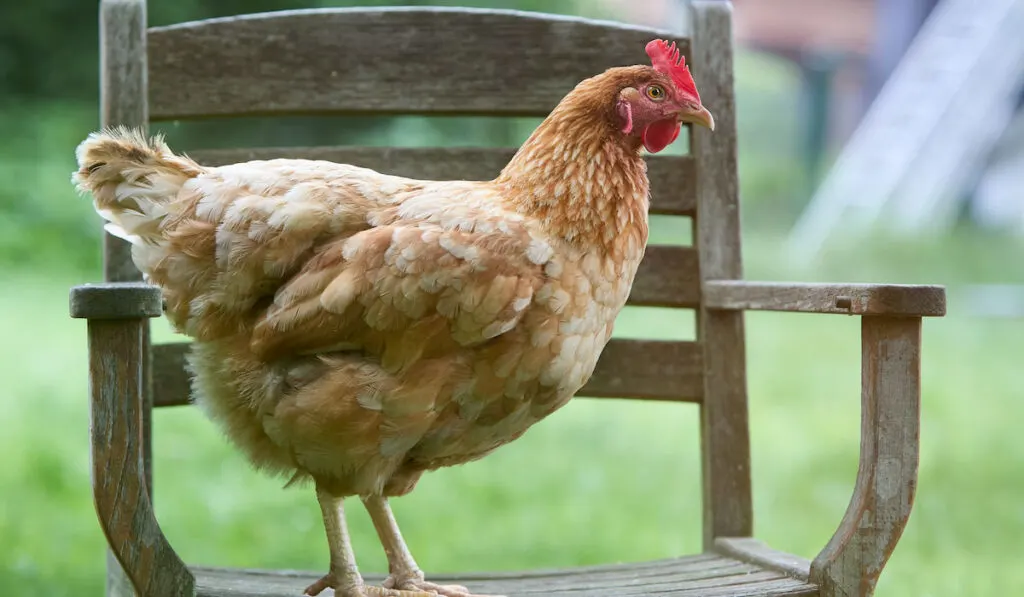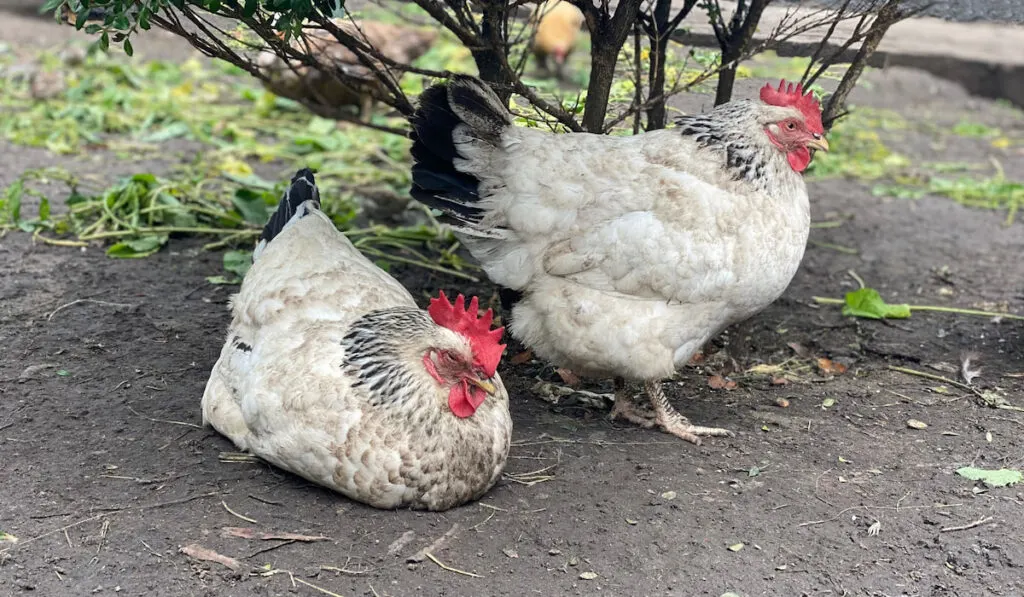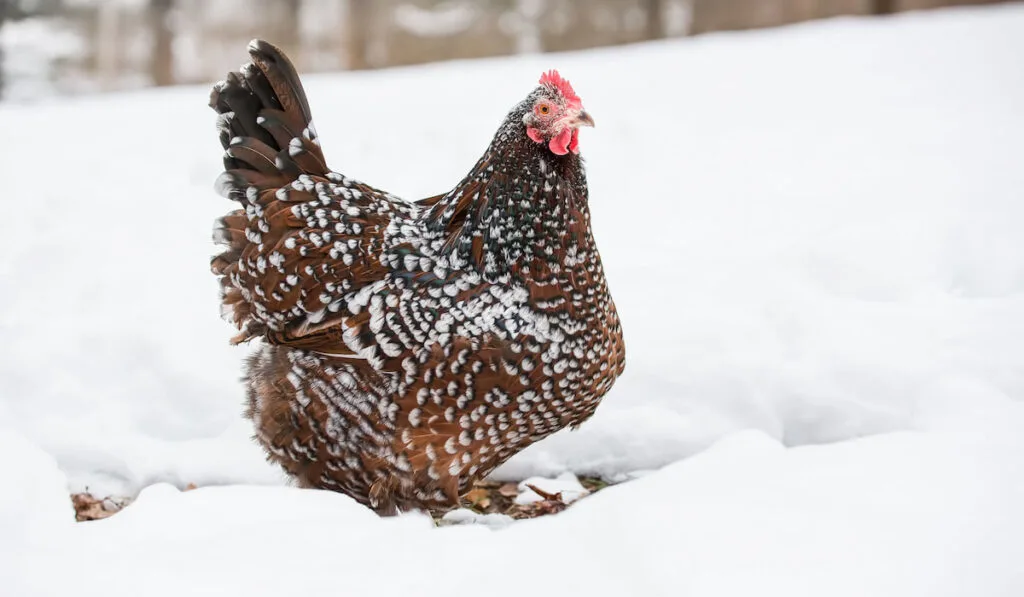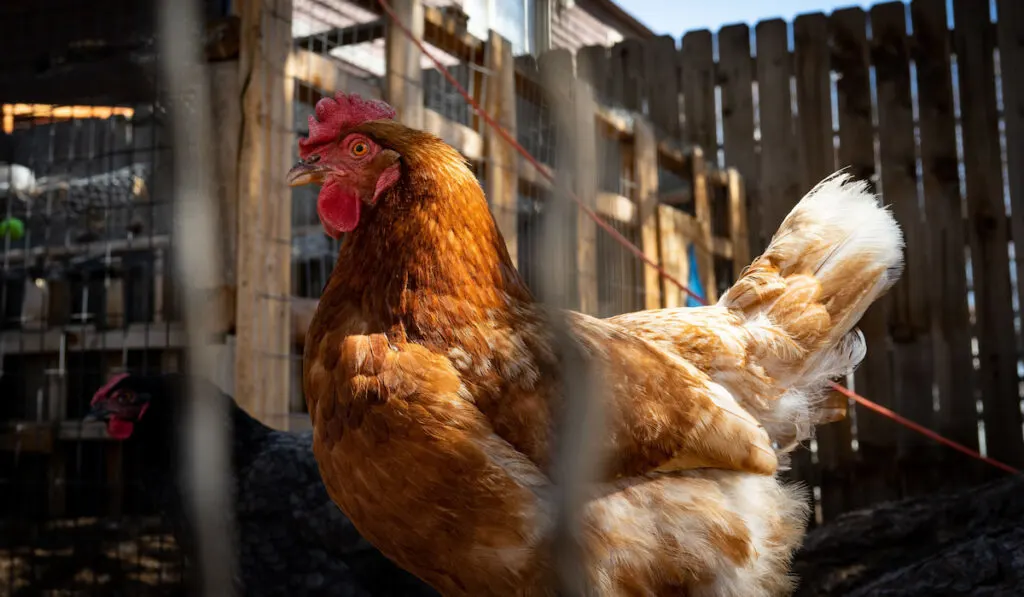The Sussex chicken has enjoyed constant, if not spectacular, success for years. It has an exciting history and has lived through the ups and downs of poultry trends.
You may be asking yourself many questions about the Sussex chicken breed. Like, how fast do they grow? Which is their country of origin? Do they have good meat? Are they good egg layers?
Luckily, this article is here to answer all your questions. Please keep reading to learn about the Sussex chicken breed’s history, lifespan, characteristics, and more.
But first, what exactly is a Sussex chicken? Let’s find out.

Table of Contents
What is a Sussex Chicken?
The Sussex chicken is one of England’s most popular and oldest breeds, which has stood the test of time for over a thousand years. The Sussex is curious, friendly, and a dual-purpose bird that makes an ideal addition to your backyard flock.
Their kind nature makes them perfect for beginner chicken keepers and those looking for a friendly chicken to add to their backyard coop.
From silver Sussex to speckled, you never feel alone with this breed as it makes an excellent companion.
Many people call it the socialist bird since it loves to interact and socialize with human beings!
The Sussex chicken is famous among backyard breeders, hobbyists, and exhibitors.
Due to its trend of becoming overweight, many poultry farmers breed it for meat rather than egg production. They combine utility and exhibition virtues.
Sussex is more prevalent in England, Canada, and other parts of the world than in the United States.

History and Origin
As the name suggests, the Sussex chicken breed originated in Sussex County in England. They were popular table birds with juicy, tender flesh and white skin, feet, and legs.
Did you know that the United Kingdom held its first-ever poultry show in London in 1845? The chickens of Sussex and Kent had the reputation of being the first exhibits.
This poultry show exhibited chickens similar to today’s red and speckled chickens. And to that effect, this formed the beginning of the Sussex chicken breed.
The Sussex continues to be a popular chicken breed in the United Kingdom.
The light type has prominently led to the development of many commercial strains. These chickens were originally reddish brown when the Romans invaded Britain in 43 A.D.
Nevertheless, poultry farmers and enthusiasts imported many exotic chicken breeds. And they produced many crossbreeds resulting in different Sussex chicken varieties.
These farmers bred Sussex with Brahma, Cochins, and Dorkings to create a more proportioned and robust Sussex chicken.
Surrey, Sussex, and Kent counties led in poultry supply for the England markets. Therefore, the development of Sussex chickens fit the need very well.
Following the hen fever that hit poultry farming in England and the U.S. in the 19th century, many people wanted to own and breed this rare species.
However, some farmers began crossbreeding the Sussex with local flocks to increase its size.
To their disappointment, this made the meat coarser and less tender. Many people no longer sought the breed due to the decline in the population of pure Sussex following the obsession.
However, traditionalists kept looking out for it, so the Sussex chicken endured the test of time.
In the early 20th century, Edward Brown, a prominent writer on the rural poultry industry, urged Sussex farmers to maintain the reputation and purity of the fine-dining bird.
Following his speech, EJ Wadman, a poultry enthusiast, formed the Sussex poultry club in 1903.
And in 1912, this dual-purpose breed made it to the United States.
The American Poultry Association (APA) recognizes three Sussex chicken varieties. They are red, speckled, and light. Britain recognizes one more type, the Brown.

What Are the Features/Characteristics of the Sussex Chicken Breed?
The Sussex chicken is a soft-feathered, heavy, attractive, and alert breed with close-fitting feathers. They are known to be brave and easy to handle.
The Sussex has different varieties with different plumage colorations:
- The speckled. As the name suggests, the speckled Sussex breeds have beautiful multi-colored plumage that gets better when they shed feathers.
- Light. (The most popular) The light breed has white plumage with black neck and tail feathers
- Red. This variety is deep red, often similar to Rhode Island Red coloring.
- Coronation. The coronation type has the same markings as the light type but has lavender (light blue) neck and tail feathers. The coronation variety was bred for the coronation of King Edward VIII in 1936. But this event did not take place.
- Brown. The brown Sussex has a deeper coloring than red and has a partridge pattern to its feathers.
- Silver. The silver Sussex is black, but their head, neck, and breast have silver penciling.
- White. The white Sussex is just as the name suggests.
- Buff. This variety has buffed plumage with black neck and tail feathers.
Depending on the variation, they have either dark orange or reddish eyes. But all variations have red wattles and earlobes.
Here are other unique characteristics of this beautiful bird.
Physical Characteristics
- They have long, broad backs. The Sussex is a graceful chicken with a rectangular body, wide shoulders, and a broad back.
- They have close-fitted feathers, which makes them look heavy and full.
- They hold their tails at a 45-degree angle, making them look perky.
- They are white-skinned birds with white legs and four toes on each foot.
- They weigh between 6-9 pounds (2.7-4 kg). The standard weight for the Sussex chicken cock is approximately 9 pounds (4 kgs). The hen weighs 7 pounds (3.1 kg). The cockerel weighs 7.5 pounds (3.4 kgs), while the pullet weighs 6 pounds (2.7 kgs).

Farming Traits
- They are sturdy, broody, and healthy. The Sussex breed family is hardy and robust, and they don’t have any significant health issues.
- They are great foragers and excellent mothers. They are very good at foraging and gather most of their needs from the garden, making them thrifty chickens. They are particularly alert and good brooders.
- They are a good source of both meat and eggs.
- They are low-maintenance birds and don’t need any special treatment or treats.
- They tend towards obesity. If you want them for meat, you can fatten them, but if you want them for eggs, you will need to watch and manage their weight.
Personality Traits
- They are very curious and may follow you while going to the gardens.
- They are not aggressive birds; you should separate them from aggressive and pushy breeds. If you keep them together, they could suffer from bullying.
- They are social, friendly, and gentle, making them ideal for beginners and pets.

Egg-Laying Capability
The egg-laying capability of the Sussex breed depends on the variety you choose. This dual-purpose bird lays around 4-5 large eggs weekly, giving you approximately 250 eggs yearly.
The eggs are tinted light brown and weigh approximately 2oz (60g) each.
The exciting thing about this breed is that they continue to produce eggs throughout the year.
Sussex chickens lay even during winter when other species have stopped egg production.
Sussex are known to take their egg-laying break only when they are shedding feathers, as all chickens do.
They have broodiness habits and make great mothers—the extent of broodiness depends upon the type you breed. Their chicks mature fast—20 weeks, except the speckled Sussex, which takes a little longer.
The speckled Sussex hens start laying eggs at about eight months – a bit later than other famous breeds. Egg production starts decreasing gradually at around five years when they start aging.
Uses
The Sussex chicken breed was traditionally popular as a table bird. While it was one of the principal meat production breeds, modern commercial species later took its place.
However, many farmers raise it today for both meat and egg production. The eggs are large, and their meat is juicy, flavorful, and has a good texture, making them popular among poultry keepers.
This chicken is ideal for retail meat production thanks to its ability to gain weight quickly.
In addition, the Sussex hens are excellent egg layers if you keep their weight down. They can give you up to 250 eggs yearly, depending on how you maintain their weight.
What’s more, you can choose to breed them for exhibitions! With all these uses, what stops you from raising this excellent chicken?
The table below summarizes the Sussex breed characteristics.
| Country of origin | United Kingdom |
| Also known as | Kentish fowl |
| Uses | Dual purpose (meat and eggs) |
| Skin color | White |
| Personality | Docile, social, intelligent, broody, |
| Varieties | Light, speckled, red, silver, white, brown, buff, and coronation. |
| Comb type | Single |
| Egg shell color | Brown/Tinted |
| Weight | 6-9 pounds |
| Heat tolerance | No |
| Beginner friendly | Yes |
| Make great pets | Yes |
| Noisy birds | No |
| Easy to maintain | Yes |
| Non-aggressive | Yes |
| Noise level | Average |
| Average lifespan | 5-8 years |
| Climate tolerance | Adjusts well to temperatures, prefers cool climates (cold hardy) |
| Temperament | Friendly, docile, and makes a good pet |
| Confinement or free range | Adaptable to both |
Frequently Asked Questions (FAQs)

Are Sussex Chicken Breeds Good Layers?
If you keep their weight down, Sussex chicken breeds lay an average of up to 250 eggs annually (4-5 weekly) per hen. They start laying eggs at around 20 weeks.
Furthermore, they lay eggs all year round, including winter, except when molting.
How Many Eggs Does the Sussex Hen Lay?
On average, the Sussex hens lay between 200-250 eggs annually, weighing approximately 2oz (60g).
What is the Color of Sussex Chicken Eggs?
The Sussex hens lay eggs that are light brown.
What are Sussex Chickens Good for?
The Sussex chicken breeds are famous for their flavorful and fleshy meat and high egg-laying capability.
How You Tell It’s a Sussex Chick
To identify a Sussex chick, look for four toes, white legs, a straight breastbone, a flat back, a 45-degree angle tail, and brown striping down the back.
Conclusion
The Sussex chicken is an excellent breed for the backyard poultry keeper. They are highly productive, easy to manage, and low maintenance, making them a perfect addition to your chicken house.
While they excel in egg and meat production, you must decide how to feed them to get your desired results.
Ready to start your flock of hardy yet delightful dual-purpose chicken breeds? Consider the beautiful speckled Sussex or light Sussex-the most commonly bred type. Which is your favorite?
This information will inspire you to add this social and delightful bird to your flock!
Resources
I wrote this article from my experience raising chickens and the following sources:
- https://www.scicultchickens.org/blog/best-breed-enter-our-digital-chicken-show
- https://www.rbst.org.uk/sussex
- https://blog.biodiversitylibrary.org/2016/05/hen-fever-and-heritage-breeds.html
- https://livestockconservancy.org/heritage-breeds/heritage-breeds-list/sussex-chicken/
- https://dodge.extension.wisc.edu/files/2012/02/AQBM-Breeds.pdf
- http://www.americansussex.org/about-the-breed.html
- https://www.homestead.org/poultry/best-chickens-for-eggs-egg-laying-chicken-breeds/
